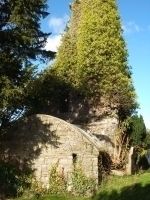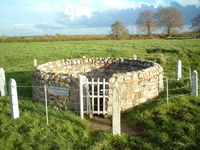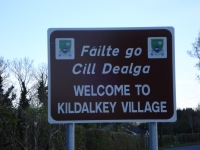Kildalkey - A Village History
 Kildalkey has a rich history dating back to the 5th century where a Monastic Abbey was founded. The Abbey, although ruinous, shows clearly the origins of our village. It has since been dedicated to our adopted saint St. Dympna.
Kildalkey has a rich history dating back to the 5th century where a Monastic Abbey was founded. The Abbey, although ruinous, shows clearly the origins of our village. It has since been dedicated to our adopted saint St. Dympna.
The old cemetery within which the ancient Abbey of St. Dympna is situated, was thought to be the centre of the mud wall town of Kildalkey. It was burnt at least 3 times by the Norse.
 About 40 years ago, some good people of Kildalkey collected a large sum of money and rebuilt part of the old Abbey and thus preserved it from falling into complete ruin.
About 40 years ago, some good people of Kildalkey collected a large sum of money and rebuilt part of the old Abbey and thus preserved it from falling into complete ruin.
Some 10 perches from the Abbey is a well also dedicated to St. Dympna. Folklore suggests that its waters possess several cures. We do not suggest that it does. The Kildalkey Active Retirement Association carried out improvement works to the well and its condition is as per the picture on the left. An aerial photograph shows an old walkway from the Abbey to the well which is not visible from the ground.
Kildalkey must have been a stirring place in the far off past judging by the remains of motes and fortifications to be seen around it. The low lying ground close to the cemetery is said to have formed part of the principal street of the anciet city of Kildalkey. In this the only church yard in Kildalkey, none but Catholics are interred. In a chapter contained in the "Book of Ceannanus Mor" (Book of Kells) said to have been written before the 10th century, the grant of this district by Conchobair Ua Maelshaughlainn to God and to Columbkille for ever with its territories and lands is recorded.
Kildalkey is called "Cill Dealga Damhnata" in the Irish language. It is also recorded that a great battle was fought at Kildalkey between the Norse and the Irish under O'Neill. The Norse were utterly defeated leaving thousands dead on the field.
An extract from the 1835-6 Ordnance Survey Field Name Book describes Kildalkey as follows:
CILLDEALGA...DEALGA's CHURCH. It is pronounced locally Kildawkey and was formerly called KILLSHALLAGO i.e. Coill Sealga - the wood for the hunting. It is situated in the centre of the Barony of Lune. Contains 10,415 acres of which 426 acres are bog and rough pasture and the remainder is arable land of excellant quality. It contains no town but the village of Kildalkey is situated near the centre and 4 fairs are held there yearly. There is a roman Catholic Chapel but no Church. The country is extremely flat. Moyrath Castle, first founded in 1215 is in this parish.
Extract from O'Donovans Letter about Kildalkey written on 5th August 1836.
This parish, which extends westwards from the parish of Trim towards the county of Westmeath, is called by the Irish Cill Dealga. The patron saint is the Virgin Davnet (Dympna) but whether or not she is the same as Davnet of Slieve Beagh I could collect nothing to determine. The site of her old Church and near it (10 perches) her well Tobar Damnata which is now nearly dried up, are still to be seen. Her memory was revered here on 15th May according to the memory of the oldest local man.

